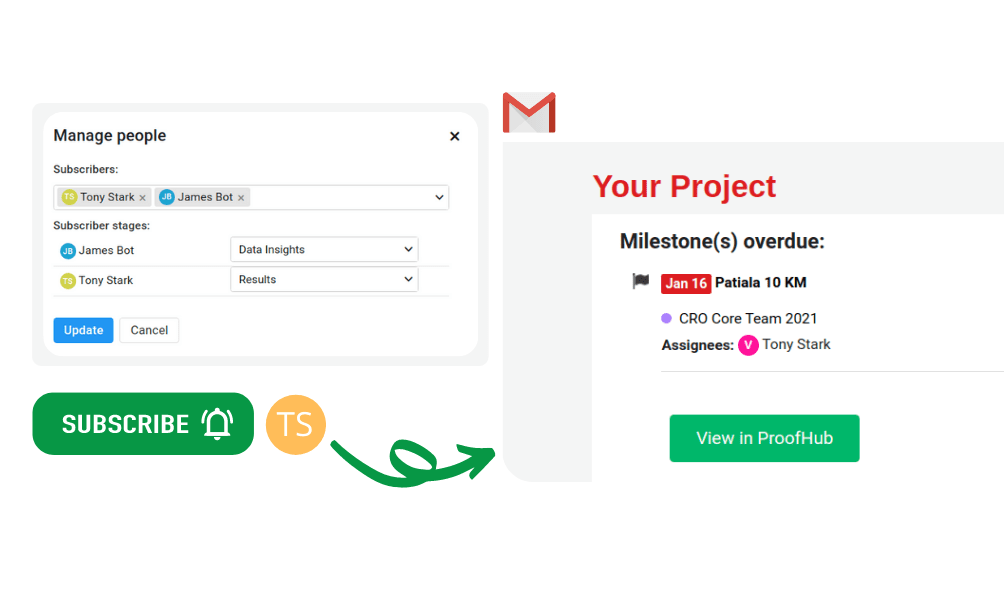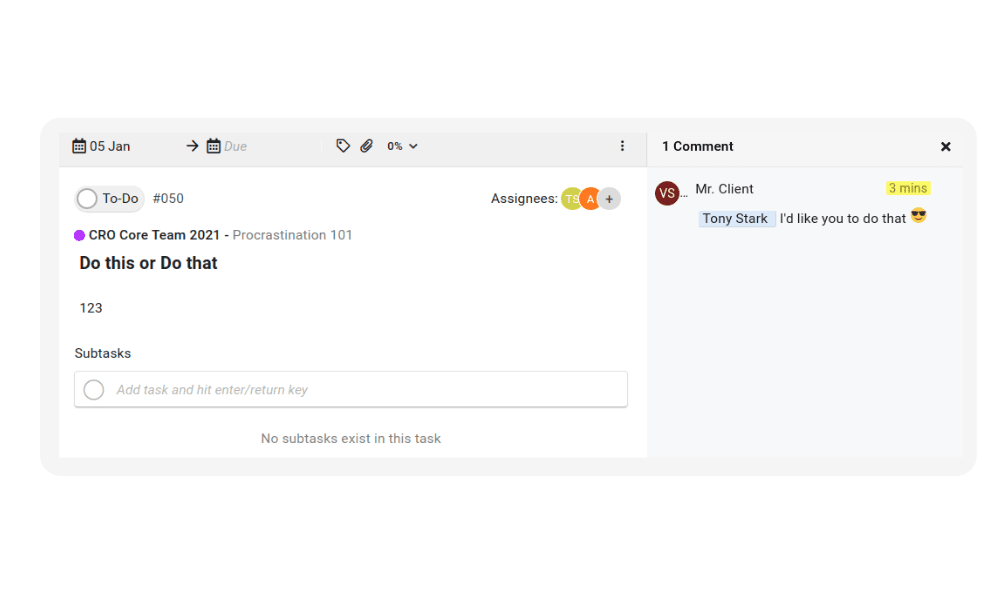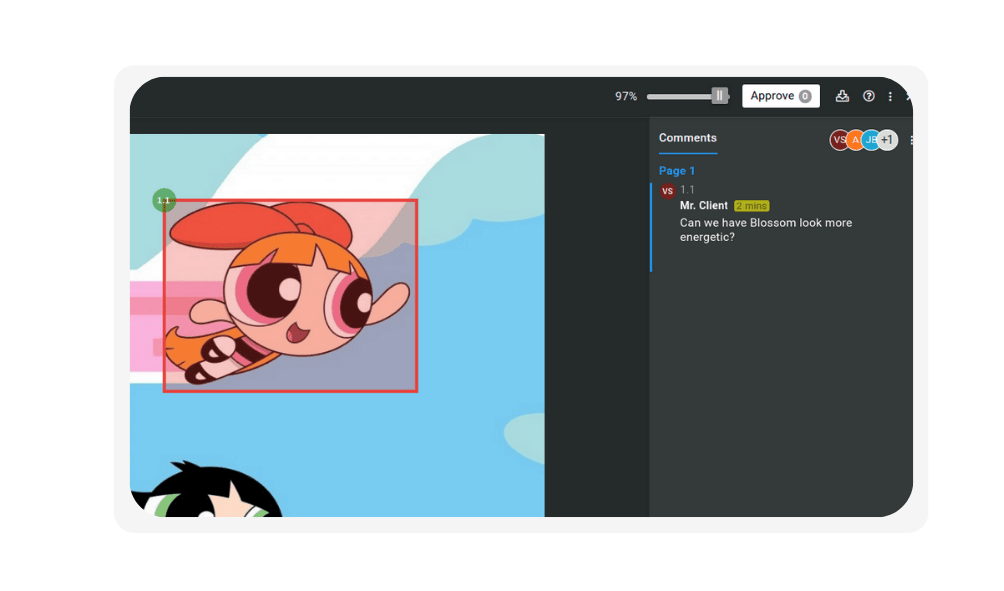Client: The last report you sent isn’t to my liking, please re-do.
Associate: Sure, I will get it done by tomorrow.
…
At first, nothing seems wrong with the above conversation. But if you carefully notice, the associate has already pushed themself in a tiring back-and-forth loop.
The associate hasn’t asked what the client’s “liking” is, therefore, they don’t really know what is wrong with it. Their best shot is a vague assumption, which reflects inadequate client communication skills.
Similarly, when it comes to effective client communication, these inefficiencies can result in productivity loss, spoiled professional relationships, and at worst, loss of business.
So, how to communicate effectively with the client?
The answer lies in developing healthy communication habits. You already have many of them but to take your client interactions beyond satisfactory, we suggest inculcating the following components in your soft skills.
Before that, let’s answer some elementary questions that are critical to effective client communication.
Table of Contents
What is client communication?
Client Communication entails the reporting, discussions, and knowledge transfer that takes place between a service provider (company) and a service seeker (client) for the fulfillment of a project.
Morgan Stanley, the Investment Bank is the client of Deloitte, the accounting firm.
Hence, associates at Deloitte will communicate with managers at Morgan Stanely for all the services that Morgan Stanley is obtaining from Deloitte.
In the same way, servicing companies constantly communicate with their client companies as per their Service Level Agreements. This includes everything from reports, project planning, video conferences, briefings, and emails.
Effective client communication has a critical role in keeping the business relations healthy and ensuring project quality is maintained as per expectations.
If you’re in a client-facing role, your communication skills have the power to make or break things. Hence, your need to hone the skills constantly and build a solid client communication strategy.
Impress clients with a professional communication interface offered in ProofHub. Try Now for Free!
What are client communication skills?
Client communication skills are a blend of language, interpersonal and emotional abilities that enable you to have clear, meaningful, and emotionally conscientious conversations with the client.
It’s no surprise that client communications have the tendency to go sideways, and the room for misunderstandings is omnipresent. A skilled communicator knows how to traverse communications effectively, leaving little to no margin for error.
A skilled communicator can be identified with the following elements in their conversations:
- Empathy
- Friendly tone of voice
- Active listening
- Courtesy
- Patience
- Ability to handle arguments
- Logical but wise
- Easy to understand
Client communication is something that is best learned by experience. Your soft skills and overall communication abilities go a long way in developing excellent client communication skills.
Why is effective client communication important?
Conversations shape experiences.
Just like a pleasant conversation with a friend can help alleviate stress, a meaningful conversation with the client will enable you to boost business relationships. Let’s establish the importance of client communication by understanding the benefits on offer.
1. Doesn’t spoil expectations
If you order Choco Latte Coffee at your favorite cafe and get served with an Espresso, you’ll feel uneasy. This is because your expectations have been let down.
While serving clients, it’s the same way around. When the communication is clear, the client knows what to expect, when to expect. This way, they feel they’re being served what they’re asked for, unlike the Espresso.
A McKinsey report states that 70% of the customers attribute their experience to how they are treated. Well met expectations lead to a merrier experience and breed a sense of professionalism.
2. Reduces clutter
Effective conversations are more like the elephant in the room, rather than a needle in the haystack. The context is easy to address, and the agenda is readily pin-pointable.
It’s not surprising that 85% of people will find it irritating if they have to repeat information while working with other businesses. In modern-day projects, this happens when clutter builds up. Effective communication reduces clutter and clearly addresses the message.
With less clutter to deal with, the instructions are easy to process for the executing team.
3. Builds rapport with the client
Good communicators always make the listeners feel good about themselves because they try to build a rapport. In the presence of a strong rapport, even difficult things can be handled without losing the client’s confidence, thus promoting loyalty.
A study depicts that loyal customers are 4 times more likely to refer your business to other people.
4. Keeps the project aligned
Poor client communication often leads to project misalignment. The tasks get plagued with delays and deadlines go for a toss.
Whereas, if the communication is on-point, the project runs smoothly at the desired pace, even when they’re hiccups.
It’s also worth noting that disorganization can breed client disinterest. Apparently, 74% of people have stopped dealing with companies that lack satisfactory internal organization.
How to improve client communication?
It’s a well-established fact that 8 out of 10 professionals rate their own business communication as average or below average.
By no means this statistic undermines your ability to communicate effectively. It’s about discovering new skills and taking care of little technicalities that clients tend to notice more.
So here are a few tactics and client communication best practices, with examples that will ramp up your client communication skills.
6 Tactics for effective client communication
1. Have an emotional connect with the client
Professional spaces may not be emotional spaces but humans are.
In order to best interpret the client, it’s necessary to connect with them at an emotional level. It doesn’t mean you have to therapize their anger issues or participate in intellectual conversations. Rather it means to be aware of sentimental connotations.
Emotional connection is mostly learned at the job. But having an understanding of what it entails will help you develop it nicely.
It constitutes four primary elements:
- Self-awareness – Understanding how you react to certain emotions so that you can identify emotional statements in a conversation.
- Self-management – Being in sync with your thoughts during the conversation so that emotional stirs don’t overpower you.
- Social Awareness – A general understanding of social setup, obligations, etiquette, and decorum when you sit down with the client.
- Empathy – The ability to understand the client’s perspective as your own, and respond accordingly.
Why it matters
Emotional connection is a necessary component of managing relationships with clients because it lets you pick-up on the deeper context of the communication.
It prepares you to deal with emotional bursts, and interpret the communication in a more humane way. This way you can manage the conversation and the relationship healthily.
As they say, if you can be yourself with people you do business with, you’re in good company.
Example:
Client: I have been following up for a week now! Urghh. Why is the bug taking so much time to fix?? Why can’t you fix it now!!!
Scenario – 1
Associate: Please be patient, we are fixing it. It’s something that takes time. You should understand it.
Client Replies: Yeah, well you’re making it sound like my mistake, and how much more time will this take? I am losing my temper on this now.
Scenario – 2
Associate: I do realize that this particular bug is taking longer than usual and believe me, we have our best people working on it. I request a little bit of patience from you, we should be able to fix it without further delays. Also, it’ll help us better prepare for similar bugs.
Client Replies: Okay, thank you for explaining the issue, I hope to get it cleared soon. Keep me posted.
As evident, in Scenario – 2, the client’s reply seems quite unalarmed, and the temper seems to have come down, which clearly isn’t the case in Scenario 1.
2. Keep the communication concise, clear and context-driven
It’s often said, “It’s easy to say difficult things and difficult to say things easily.”
The true art of effective communication lies in expressing in an easy-to-digest way.
But what is that “easy-to-digest” way?
Something is easy to digest when;
- It is said in carefully chosen words and uncomplicated diction.
- It explains the speaker’s perspective in just the right amount of words.
- It is said to keep the authority, state, and relevance of the listener in mind.
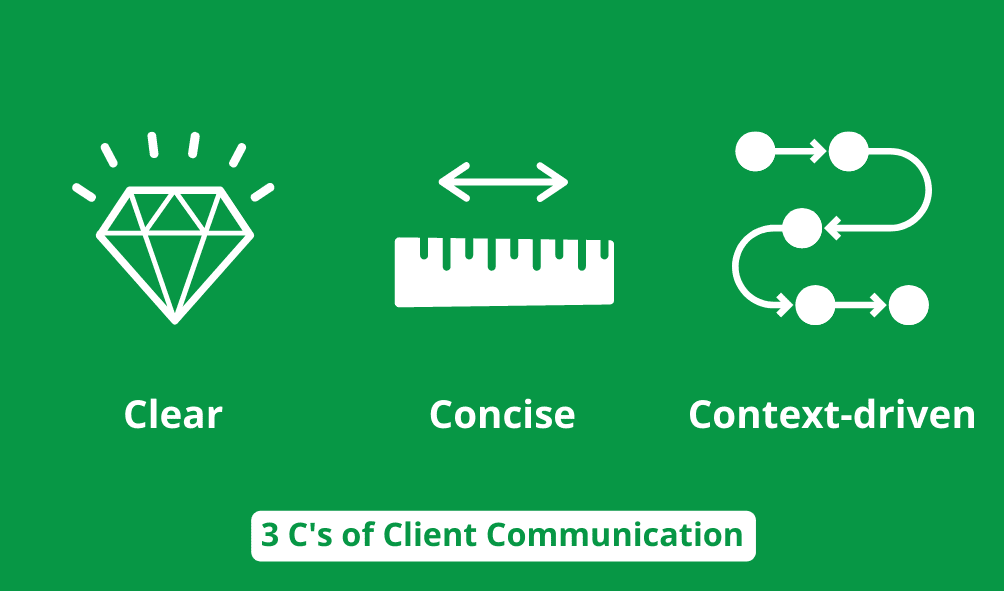
In our case, these statements translate as follows;
- Communicate important factors such as progress status, deadline, costing, etc, in definite terms. Avoid using terms like, “almost”, “perhaps”, “numerous” – as they lead to confusion.
- Keep your client conversations agenda-based. Hold discussions that matter right now and plan when to discuss what. Trying to fit too much in a single conversation can backfire.
- Be aware of how certain information will be received by the client. Pay attention to the context of the agenda in hand, and who it is being reported to.
Why it matters
The purpose of keeping client communication clear, concise, and context-driven is to avoid confusion while running the project. It enables you to healthily manage client expectations, and prevent overcommitment or false affirmations from getting into the picture.
It’s easy to lose context in a large project and seemingly simple things can turn upside down. Therefore, going the extra mile for maintaining context is always recommended.
Modern client communication software helps you maintain context in your conversations with visual aids and rich annotations. You can get your point communicated elaborately without saying too much using the right tools.
One such tool is ProofHub, which allows you to keep context alive in your client communication sessions, with the help of a collaboration-friendly ideology.
- You can subscribe clients to automated email updates regarding their projects so that they’re always in the loop.

- Clients can comment on tasks, calendar events, and files, to easily share feedback.

- You also have Document Proofing with in-file annotations, and comments that prevent contextual errors from taking place.

Get approvals and client feedback quicker with ProofHub’s smart file proofing. See how it works.
Example:
Client: So, I have shared the requirement analysis. Could you revert with a timeline for project fulfillment?
Scenario – 1:
Associate: Sure. I’ll go through it and reply with the thoughts I and my team have in some time. Thanks!
Client Reply: Could you give more clarity on when you’d be able to do that. I am unsure of things here.
Scenario – 2:
Associate: Thank you for sharing the requirement analysis, I’ll discuss it with the team and share the project timeline by 5 PM Tomorrow. In case I have follow-up questions, I will let you know by 11 AM in the morning.
Client Reply: Perfect, thanks! Appreciate the detailed response.
In Scenario 2, the associate has mentioned a definite time and date of when the client should expect the response. The associate has also informed about the requirement of additional questions that’ll keep the client ready, ensuring smooth project flow.
3. Keep a check on the tone
Most of the time, “how” things are said, is more important than “what” is being said.
If you have ever taken up a client communication training program, you’ll know why so much stress is laid upon tone and voice. This is true for both written and verbal communication.
The tone of voice and the way it is used in the conversation reflects upon the hidden connotations, that are open to unintended interpretation.
- If the tone is loose – the client may interpret it as a lack of interest in their project
- If the tone is harsh – the client may think you’re being disrespectful.
- If the tone is too strict – the client may find it hard to communicate openly.
- If the tone is reluctant – the client may find the associate underconfident.
Therefore, even if you never intended to be loose, harsh, strict, or reluctant, your tone might give it away. In most cases, we communicate with the best of intentions but the tone totally changes the impact. And in the fight between intentions and impact, impact always wins.
Clients are the happiest when the tone is professional. If you’re wondering what professional tone entails, here are a few helpful points:
- Exhibit confidence.
- Be courteous and sincere.
- Use language that is non-discriminatory and unbiased.
- Always keep “how this benefits the client” in mind.
- Avoid tone that is accusing in nature.
Why it matters
By using the right tone with the client, you ensure that the message you’re trying to communicate is received as intended.
It’s one of the foremost client communication skills that allow you to have a smooth flow of conversation. It also helps you build a rapport with the client, and formulate a strong client relationship.
At times, the right tone makes difficult conversations easier to digest and maintain a mutual sense of respect with the client.
Example:
Client: Could you update me on the status of the urgent task due today. I am unable to find the deliverables, it’s already 2 hours past the deadline.
Scenario – 1
Associate: I am sorry that task couldn’t be done, and I forgot to tell you about it. You didn’t give me enough time for it.
Client Reply: What? You’re telling me this now? You never asked for an additional time! This is nonsense.
Scenario – 2
Associate: It brings me great discomfort to inform you that the task is a little off-track. I am asking this in an untimely manner, but it’ll be great if you could extend the deadline by a few more hours. We should be able to complete it without fail, thank you!
Client Reply: It should be done by now, but a few hours is fine, you can let me know about it once done.
In this case, while addressing a delay, a non-assertive and considerate tone has helped in alleviating the situation. It’s always recommended to take care of the tone while having difficult conversations.
4. Use emphasis and subordination appropriately
It’s safe to assume that certain ideas require more attention than others. You might want to emphasize the benefits of your product but downplay the costs if they tend to be higher in competition.
Use emphasis when you want to lay stress on an idea that MATTERS MORE.
You can always subordinate the idea that requires lesser attention as it might not form the central objective of the conversation, and just take more time in communicating, in general.
In the previous two sentences, the concept of subordination is already downplayed, whereas, the concept of emphasis clearly stands out.
That’s how you can effectively get your message through to the client.
Tactics for emphasizing and subordinating in a client meeting;
- Delegate more time to ideas that need emphasis and bring them up in the discussion promptly.
- Use a concerned tone for communicating important ideas, and plateau your tone when you have to subordinate an idea.
- In written communication, use formatting clues for highlighting ideas that need immediate attention.
- You can choose to communicate important ideas in an active voice, whereas subordinated ideas are best left to a passive voice.
- If you’re using project management software, use color clues, or project tags to assign priorities to ideas being communicated to the client.
Why it matters
Having clear segregation of what should be placed on the top, middle and bottom will help you keep the communication highly organized.
Client communications tend to become complex. If all the ideas get the same priority and time, you may never be able to finish a meeting. Hence, being aware of the bigger fish to fry will enable you to have meaningful conversations, without having to compromise on quality.
Example:
Scenario – 1
Client: How does the sales forecast for Q2 look like?
Associate: The sales forecast LOOKS BAD. We haven’t met the current quarter targets and the only good thing that has come out is our customer feedback has improved.
Client Reply: Oh, I need to meet your manager on this, we might consider another agency from now on.
Scenario – 2
Associate: Before we get into the sales forecast, I’d like to mention that our customer feedback has significantly improved. Our customer satisfaction ratings have gone up considerably. Regarding sales for Q2, we are a little lost at the helm, but efforts are positively aligned.
Client Reply: It’s good to know that customer feedback has improved. We need to work on sales now. Anyway, thanks for the updates!
Here, the idea is to break the bad news to the client by laying emphasis on the positives and subordinating the negatives. While you’re presenting the facts as they are, the slight moderation in language makes it more digestible.
5. Be an active listener
Listening is the most undervalued client communication skill.
It’s easy to list down the greatest speakers of all times – Barack Obama, Nick Vujicic, Abraham Lincoln; but do you know the greatest listeners of all times?
That’s someone you should aspire to be.
It’s a well-established fact that we retain only 25-50% of the conversations we have with someone. Clients are no different. But with practicing active listening, this percentage can be increased.
Active listeners become keen communicators.
They’re able to absorb the client’s instructions precisely and exhaustively while making minimum interpretation errors. When you’re an active listener, you’ll be able to ask the right questions, clarify doubts promptly and ensure you have understood the client accurately.
In order to practice active listening, the following points are a great help;
- Practice focussed listening that helps you absorb information without deviating from the subject.
- Use acknowledgments such as verbal nods, and affirmative words, at constant intervals to make the conversation sound less like a monologue.
- Engage the speaker with follow-up questions to derive more information from the speaker.
- Pause and rephrase the speaker at points where you’re not sure about something
Why it matters
Active listening helps you avoid confusion, reduce back-and-forth loops with the client, and prevents delays that arise out of inefficient absorption of information.
You can greatly reduce the efforts to complete a client project, and keep your team productive with sharp active listening skills.
Example:
Client: The first point of Report A colludes with the fifth point of Report B, please check why is that the case. It’ll be great if you could resolve Report B today.
Scenario – 1
Associate: As you had asked, I looked over the points and resolved the first point of Report B, it’s done now. Please review.
Client Reply: Oh no, I had asked to check the fifth point of Report B, not first! You didn’t listen to me attentively.
Scenario – 2
Associate: Thank you for the review. I have checked both the points and made amends for 1st point in Report A and the 5th point in Report B. Please review if everything is all right now.
Client Reply: Perfect, that’s what I had asked for. Thank you for the response.
Here, Scenario 1 is a typical case of improper listening. The associate didn’t absorb the feedback accurately which will delay this task indefinitely. Whereas, in Scenario 2, things went as planned.
6. Use a client communication tool
As remote work becomes a way of life and offices go mobile, most client meetings will be held virtually. It’s not surprising that 55% of employers globally offer remote work opportunities, and 90% of remote workers readily recommend it to their friends.
Considering the virtual nature of communication, the need for a reliable Client Communication Tool becomes apparent. When most of the team members, including the client, are geographically scattered, it takes more than phone calls and video conferences to maintain effective communication.
Therefore, a tool that could bring team members, clients, and team managers on a central platform for communication is necessary.
The Client Communication system becomes a pivotal part of the communication process and subsumes many other activities such as Client Reporting Management, Client Collaboration, and Productivity Reporting, in it.
Start improving how you communicate and collaborate with the clients. Switch to ProofHub.
Why it matters
It was found that project management software is a common link among 77% of all high-performing projects.
Project management software is invariably used in the place of Client Communication Tools, forming the backbone of highly productive teams. Therefore, these tools have taken the center stage for effectively managing teams and clients in professional environments.
If you’re heading a remote team or looking to revamp in-office client communication, using a software tool can help you reach the flow and effectiveness you’re looking to achieve.
How to choose a client communication tool for your business?
A great tool is always the one that adapts to your business easily and offers value for money.
Therefore, when you’re in the market to shop for client communication tools, the first step is to figure out what exactly you want.
Here are a few typical use-cases that client communication tools support;
| Client Reporting | Email Alternative | Client Support and Resolution | Client Relationship Management | Client Project Collaboration | Client Meetings |
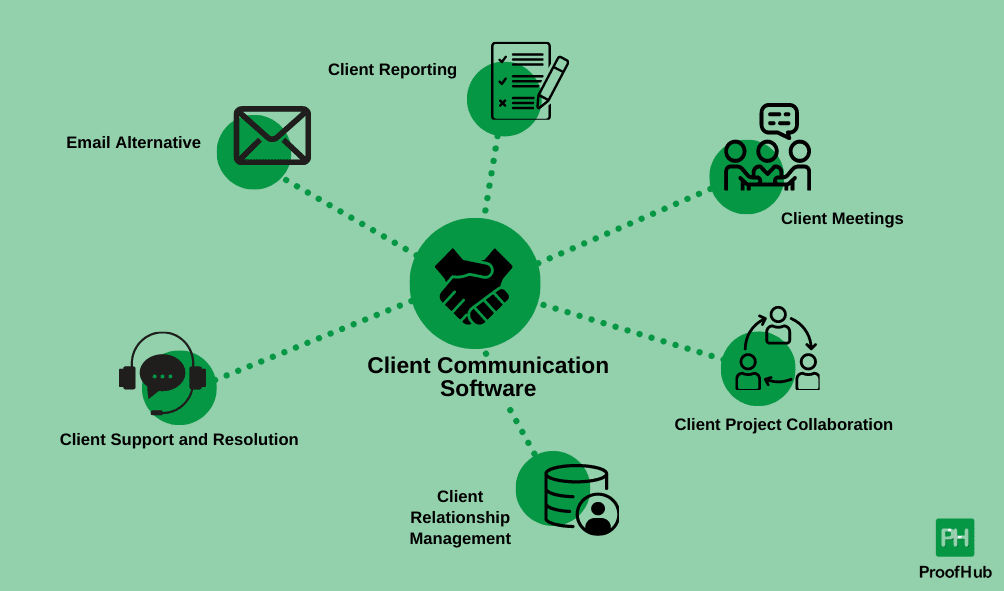
Does any of the above use-cases ring a bell? If yes, you need to look for a tool that caters to your specific use case as its USP.
Many a time, you’ll not need a full-blown project management suite and a nifty VoIP software will be enough. Whereas some companies such as IT, Graphic Design, Accounting, etc, need to share each little update with the client, which requires a strong collaboration software.
Once you’ve figured the exact use-case native to your requirements, consider the following factors for further narrowing down your search.
Client communication software must-haves
Easy Client On-boarding
The tool should allow you to make accounts for all the client-side stakeholders easily. In most cases, you’ll get a CSV import option or a self-serving registration option. Make sure this is not amiss in the tool.
Offers Multi-user Collaboration
Client meetings are rarely one-on-one. You’ll have multiple people in the office exchanging information with the client, which makes it necessary to offer multi-user collaboration features. Simply put, your team and the client’s team should be able to get on the same tool without hassles.
Email and Mobile Notifications
If you miss a chat message on LinkedIn, you get an email notification and a mobile app ping as well. Similarly, your tool should send out emails each time an update is shared with the client. Having a mobile app solution for instant push notifications will be super handy.
Provision For Client Feedback
The tools should offer features such as annotations, comments or chat, in order to capture the feedback easily. This not only helps maintain two-way communication but also reduces the need for frequent phone calls.
Scalable Pricing
It’s always wise to look for a tool that doesn’t put price constraints on your growing team or clientele. Go for an option that makes scaling cost-effective for you. Something that can accommodate your expansion plans for at least a year.
Communicate with clients using ProofHub
ProofHub makes client communication effective, allowing you to discuss, ideate, and report on client projects, all using one tool.
Clients are the happiest when they feel in charge of their project. ProofHub enables you to deliver that first-class experience by making your clients a seamless part of your process.
ProofHub not only checks out on client communication must-haves but also offers a suitable solution for your internal team to stay productive.
It’s as beneficial for your client servicing as it is for managing your in-house team.
A definite plus is its flat monthly fee that lets you create as many projects, and on-board as many clients as you like.
Get a closer look at ProofHub, get started with a free full-feature trial in just one click.
Conclusion
Ready to make client communication your strong suit?
Follow the effective client communication tips mentioned in this article, and start applying your learnings at your work. I am sure there is more to client communication skills than I could cover in this bit, and I would love to know your thoughts on the same.
Join me in the conversation on LinkedIn, where I discuss many such ideas with thought leaders and excellent communicators.

